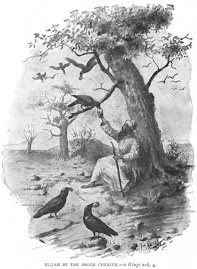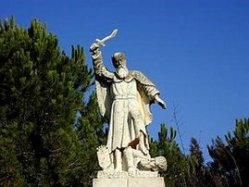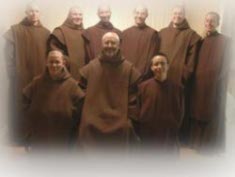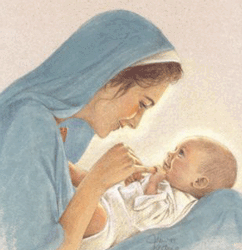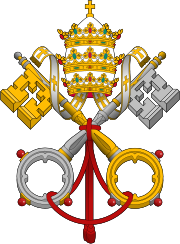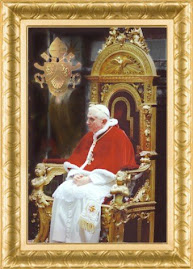Directed to Christ and oriented to Him, Carmel is also directed to Mary and oriented to her. "Completely Marian", "Totus marianus est," Carmelite authors like to repeat throughout the centuries, and of all their titles none is dearer to the sons of Elias than that of Brothers of our Lady. It is historically certain that the first hermits who retired to Mount Carmel in 1150 made their center a chapel consecrated to our Lady and from the time of Saint Brocard, the first Prior General, the Carmelites were called Brothers of our Lady of Mount Carmel. So devotion to our Lady is seen to be one of their distinctive signs. "Despite its historical inexactitudes "L'Institution des premiers moines" shows that the Order isdominated by the two great figures which represent, on different levels, its ideal: "Elias and our Lady" [1]. No need to follow the example of medieval Carmelite authors, in particular Bostius, and multiply the subtle and often forced resemblances between Elias and our Lady. The origin of these resemblances is to be found in a mystical interpretation of the scene in the book of Kings where on the heights of Carmel, at the prophet's prayer, a little cloud, about as big as the palm of a man's hand, rises out of the sea, melts into rain and fructifies the parched land: this is the image of the Virgin who was to give the Savior to mankind (3 Kings 18: 44). Nor is it necessary to do what Baconthorp did about 1330 and seek to establish close parallels between the life led by the Carmelite and the life of our Lady. "We have chosen a Rule", he said, "in which many points are similar to the life led by the Blessed Virgin Mary". If this be so, why does this Rule never once mention our Lady's name? Nor is the name of Elias found in its pages (in fact no reference is made to the fountain of Elias in the primitive texts). Nevertheless it is certain, as the Order's many authors and documents repeat, Carmel belongs to Elias and to our Lady. "Marianus et Elianus Ordo Carmeli", is the way it is expressed in the Mirror of the Carmelites, or the History of the Order of Elias of the Brothers of the Blessed Virgin Mary of Mount Carmel.
At Carmel what is true of our Lady is also true of our Lord. Contemplative life advances by assimilation and union, much more than by images, examples and models. Preserving all due proportion, what we have said of Christ we repeat about Mary. If the Carmelite does not strive to imitate Mary's life, he does find himself quite naturally in deep harmony with her soul, and it is in this sense that he may be said to lead a "Mary-form" life. Our Lady is for him not only the Mother of Christ and his own mother. She also represents and expresses the soul's essential attitude before God. Mary not only sums up the whole Old Testament, she represents all mankind. She is its soul athirst for God, longing for Him, hoping for Him. All her strength and all her faculties are turned toward Him so that she may receive Him and fully live by Him. Our Lady is also the place of the divine response, of the divine coming. In her, mankind becomes conscious of God's desire and His fully efficacious will to communicate Himself to man. Mary is the place of this meeting; better still, she is the temple in which is consummated God's espousals with man, the hidden sanctuary in which the Spouse is united with the bride, the desert which flowers at the breath of God. Our Lady is pure reference to God and to the life of God in the sense in which Eliseus said to Elias: "As the Lord liveth and as thy soul liveth". From the moment of her immaculate conception Mary's soul had no other life than God, no other end than to know Him and to love Him purely and without any admixture and to allow Him to accomplish in her His designs of love. Carmel finds in Mary the fullness of the spirit which is its own: her beauty is without spot, her purity is absolute. As Isaias says: "The beauty of Carmel will be given you" (35: 2). Reciprocally, Mary's soul is connected with Carmel. She is a daughter of David according to the flesh, the daughter of the prophets and the daughter of Elias according to the spirit. In biblical times souls sought to make the perfect response that Mary was to give to the Word of God which (Luke 2: 19) and on which she "she pondered in her heart""meditated day and night". They longed for the ardent zeal with which she was aflame under the action of the Spirit of God. But her virginal maternity made this predestined daughter of Carmel a queen and raised her to a place of sovereignty among her brethren. For this reason, Carmel will live Mary and will breathe Mary with a movement as natural and as spontaneous as it is willed and conscious. To advance along this path the Carmelite has but to intensify his Marian attitude of virginal simplicity and pure reference to God. At Carmel, God is the object but the soul will become more and more Mary. So the reason why the Rule does not mention our Lady is clear. Carmel seeks to gaze upon God and love Him with mind and heart. What Mary represents is the soul itself. As the soul is united to Christ, so Carmel is hidden in Mary. Mary is, beyond any doubt, for Carmel the infinitely admirable and lovable Mother, the all-merciful Mother, but deeper than this, she is the one who was chosen and formed by God to be the Mother of the Savior; she is the purest, highest and most perfect expression of the soul that is open to the divine action and lives in Mary's light and in Mary's love. She is, par excellence, the contemplative soul. This mystic and filial intuition is to be confirmed in the centuries that were to come. In a critical hour, our Lady herself answered the trusting, insistent prayer of Saint Simon Stock. She appeared to him, holding in her hand the scapular of the Order, and said: "This is the privilege that I give you and all Carmel's children. Whoever dies clothed with this habit will be saved" [2]. In this way she extended, in visible fashion, her special protection over the Order which has always called itself her own. Mary was to intervene in the lives of Carmel's saints. Saint Albert of Sicily, Saint Andrew Corsini, Saint Peter Thomas, Saint Teresa, Saint John of the Cross, and in our own days Saint Theresa of the Child Jesus were favored with our Lady's visible protection. It seems as if at Carmel there can be no great servant of God who has not been sustained and guided by Mary.
Similarly, Carmel's authors multiply works which tighten the already close bonds between Carmel and our Lady. The Order was founded for the veneration of the Blessed Virgin. The Rule was formulated in connection with her life and virtues [3]. In one sense, the objectivity and value of these connections matter little. It is certain that between the time of the Rule and the Reform, "the idea of our Lady taken as model greatly gained in precision... and it becomes clear that Carmel was established for her honor". Was it not normal and at the same time the manifestation of an altogether filial spirit for Carmel to give the Blessed Virgin Mary honor that expressed something of her own intimate fervor. "The first hermits of Carmel considered Carmelite life as existence equally dedicated to the service of the Lord God and of His Mother, the Virgin Mary. Better than all the legends, this expression permits us to understand the flowering of Marian piety at Carmel and the true meaning of later official texts which affirmed that the Order of Carmel is dedicated from its beginning to the honor of our Lady."[4] Carmel sees in her the "soul" in the presence of God. Her purity and simplicity are ravishing. She is the soul whom God has completely and absolutely unified. In her is admirably made manifest: the omnipotence of the Spirit, the origin of contemplation, the origin of the apostolate. Through Mary Carmel perceives the ideal toward which it is drawn and which attracts it. This is a life of unity in God, of union with Christ, of efficacious and salvific charity toward men. Of course, for Carmel as for every Christian soul, Mary is above all, the Mother. "She is more mother than queen", affirms Saint Theresa of the Child Jesus. But she is also something more. She is "the beauty of Carmel". What does that mean? Under this mysterious title, Carmel tries to express something of what she means to the Order: a brightness of eternal light, she in whom God allows Himself to be contemplated and cherished, she in whom "the divine light knows no shadow". Now we understand why, at Carmel, at least for certain souls, Mary is intimately associated in the very practice of contemplation. In her the Lord has done great things. The purity and transparency of her soul enables us to see God at work in her and to contemplate in her a reflection of the divine Beauty. This soul, so transparent, is, we know, that of our mother. Her mission is to form us to live a life of union with God such as she enjoyed. How could our path not lead us to her? So we see that at Carmel there has always been a contemplative way on which union with Mary, far from being an obstacle, or even a detour, is envisaged as an essential condition of advance to the highest mystical life. "The soul discovers that Marian contemplation does not lead her away from adhesion to or immediate union with the Sovereign Good and the simple essence of God considered in itself. On the contrary the soul finds herself attracted to God with greater facility and is held by Him with greater stability.... All this is effected in the soul by one and the same Spirit, the author of this Marian life which leads finally to a perfectly mystical life."[5]
1. FRANCOIS DE SAINTE-MARIE, "La Regle du Carmel et son esprit," Edition
du Seuil, 1949, p. 112.
2. Viridarium in "Speculum Carm.," 599.
3. JOHN BACONTHORP.
4. ELISEE DE LA NATIVITE, O.C.D.: "La vie mariale au Carmel," "Maria,"
II, p. 839, Beaucheane.
5. MICHEL DE SAINT-AUGUSTIN: "La vie Marieforme."
Credits: fragments taken from the essay on "Carmelite Spirituality" by Fr Paul Marie de la Croix, OCD - link on the sidebar in Carmelitana section





